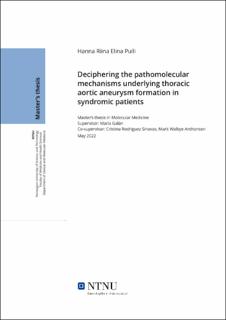| dc.description.abstract | A thoracic aortic aneurysm (TAA) is local dilatation that occurs in the major blood vessel from which blood flows to the aorta. In the worst case, weakened dilation can lead to rupture. Clinical decision making for the management of thoracic aortic aneurysms is based on diameter monitoring and surgery. Novel drugs to prevent, stop or revert the dilation of the aortic wall are urgently needed. This study aimed to identify new therapeutic targets among those related to the endoplasmic reticulum (ER) and mitochondrial stress to handle aortic aneurysms in syndromic patients.
This study included three study groups; syndromic patients and non-syndromic patients, which were divided into bicuspid and genetic patients. Healthy donors formed the control group. Aortic wall tissue specimens for RNA extraction were collected from 43 patients. Gene expression was investigated by Illumina RNA sequencing to identify the differentially expressed genes (DEGs). Using bioinformatic analysis, the most significant DEGs were selected and analyzed. DEGs were validated with a quantitative real-time polymerase chain reaction. To measure circulating levels of selected candidate genes, including markers of ER stress and mitochondrial biogenesis, an enzyme-linked immunosorbent assay was performed for serum samples. In addition, to examine changes in the aortic wall structure, histological analyzes were performed.
Among the top-50 DEGs, we identified four genes exclusively upregulated in bicuspid TAA patients and eight genes exclusively upregulated in syndromic and genetic TAA patients. One gene was identified as upregulated in the damaged tissue of all three patient groups. DEGs were associated with many enriched inflammation pathway clusters. However, enriched pathway clusters related to homeostasis, mitochondria, and extracellular matrix were also noted. Enrichment and upregulation of chosen ER stress and mitochondrial biogenesis markers suggest that ER stress is somehow involved in TAA development. Clear differences in the circulating protein levels among patient groups could not be seen. Histological staining’s strengthen the existing perception that dissimilar pathological features found in the wall of TAA are associated with patterns of aortic remodelling according to the dissimilar groups of the study. | |
